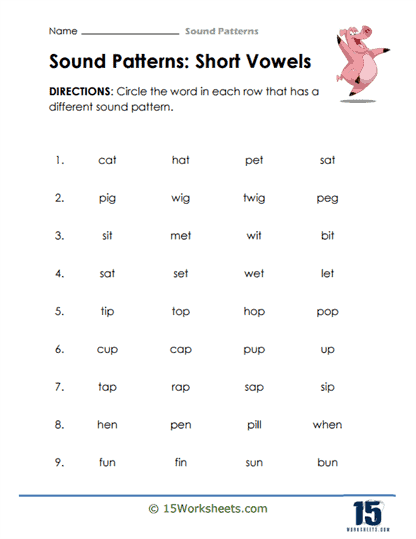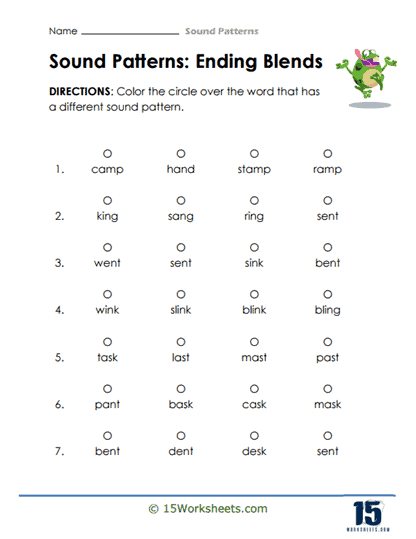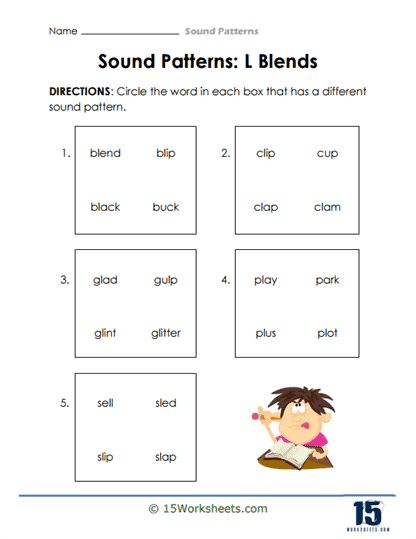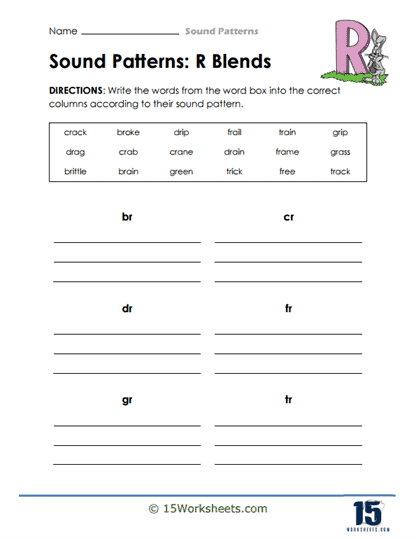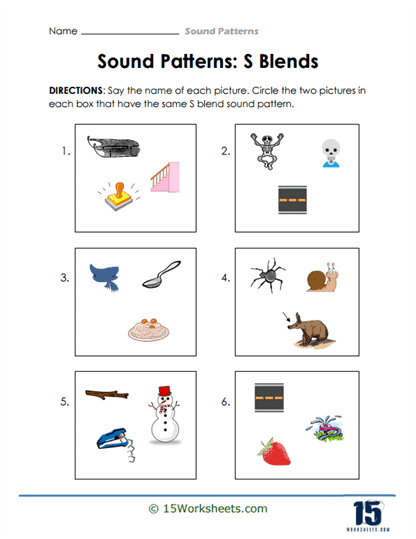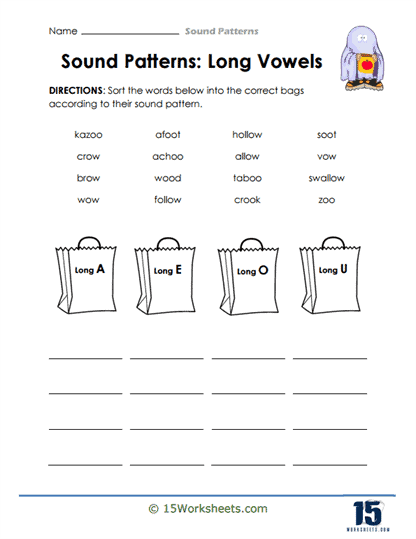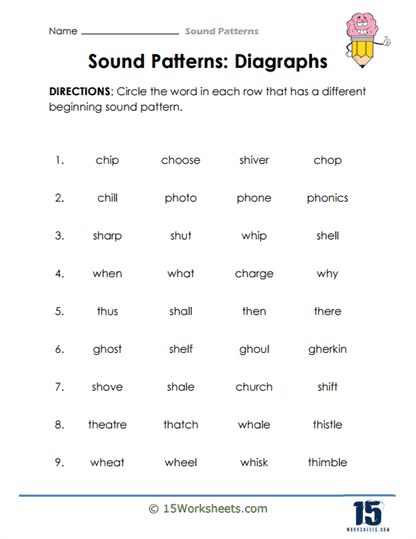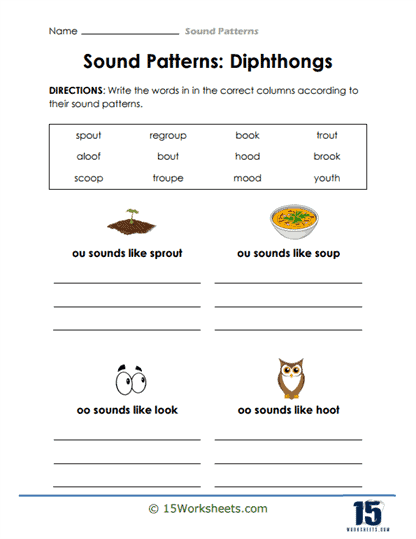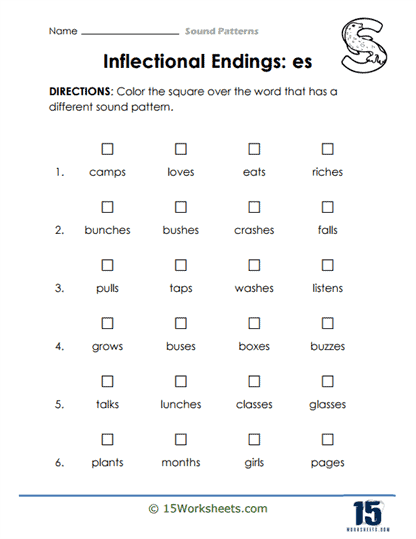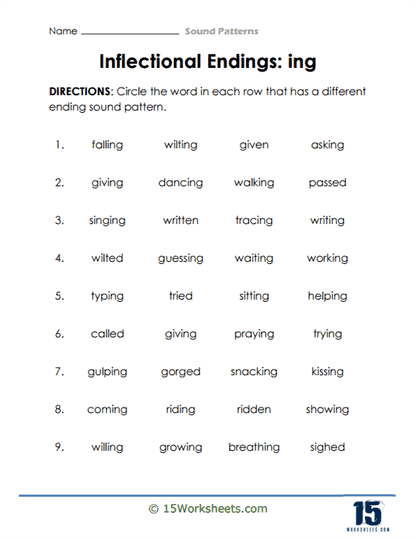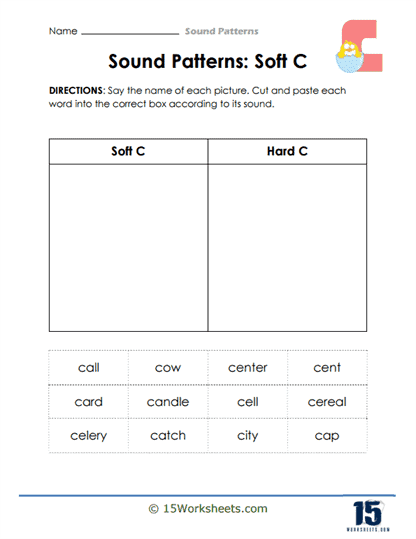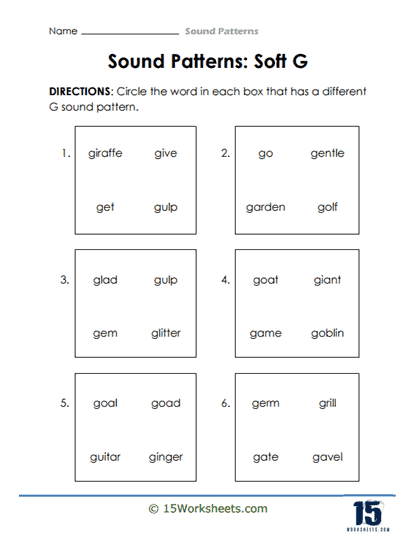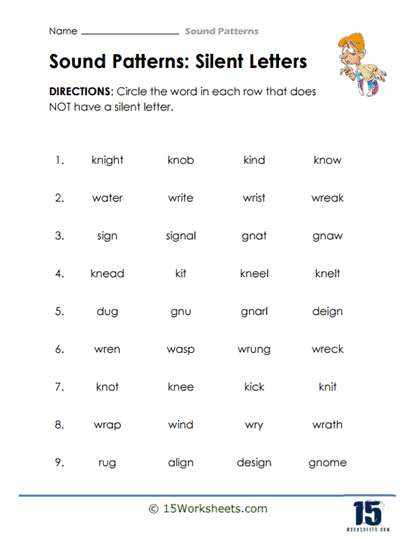Sound Patterns Worksheets
All About These 15 Worksheets
Sound patterns are the rhythmic and melodic elements that underlie language. They are the music of words and play a crucial role in our ability to understand and produce speech. Teaching students about sound patterns is essential as it enhances their phonological awareness, which is the ability to recognize and manipulate the sounds of language.
To empower students to become adept at recognizing and using sound patterns, we proudly present a collection of Sound Patterns worksheets. These worksheets have been thoughtfully designed to provide students with structured and engaging opportunities to practice and refine their understanding of sound patterns.
What are Sound Patterns Worksheets?
They are designed to help students practice and learn about the patterns of sounds in words. They include various activities, such as matching, sorting, or writing exercises, that focus on identifying and distinguishing between different sound patterns in words.
How to Recognize Sound Patterns in Words
Recognizing sound patterns in words is an essential skill for developing reading and language abilities. Here are some strategies to help you recognize sound patterns in words:
Identify Rhyming Words – Rhyming words have the same ending sound patterns, such as “cat” and “hat” or “door” and “floor”. Pay attention to these patterns when reading or listening to language.
Break Words into Syllables – Divide words into smaller units (syllables) to identify recurring patterns. For example, the word “butterfly” can be broken down into “but-ter-fly”. This helps you recognize the patterns of individual syllables within words.
Analyze Word Families – Word families are groups of words with the same root or base word, such as “run”, “runner”, and “running”. By identifying the common base word, you can recognize patterns and understand how words are related.
Learn Common Prefixes and Suffixes – Prefixes are added to the beginning of a word, while suffixes are added to the end. Familiarize yourself with common prefixes (e.g., “un-“, “re-“, “pre-“) and suffixes (e.g., “-ing”, “-ed”, “-ly”) to recognize patterns in words and deduce their meanings.
Focus on Vowel Sounds – Vowel sounds, such as short and long vowels, play a significant role in sound patterns. Learn to differentiate between short and long vowel sounds and understand when they occur in words.
Study Consonant Blends and Digraphs – Consonant blends are two or more consonants that appear together in a word but maintain their individual sounds (e.g., “bl” in “blend” or “st” in “stop”). Consonant digraphs are two consonants that combine to form a single sound (e.g., “ch” in “chair” or “sh” in “ship”). Learning these will help you identify sound patterns in words.
Understand Phonics Rules – Phonics rules, such as the soft and hard sounds of “C” and “G”, can help you recognize sound patterns in words. Familiarize yourself with these rules and apply them when reading or listening to language.
Practice Listening and Pronunciation – Listen carefully to native speakers and pay attention to the rhythm, stress patterns, and intonation of their speech. This will help you develop a sense of the natural sound patterns of the language.
Use Word Games and Puzzles – Engage in word games and puzzles, such as crosswords, word searches, or anagrams, to practice recognizing sound patterns and improve your language skills.
By using these strategies, you can develop a better understanding of sound patterns in words and improve your reading, pronunciation, and language comprehension skills.
Common Patterns of Sounds in Words
We have worksheets for all of these different sounds. Click on the name of the sound pattern to visit those sheets.
Consonant-Vowel-Consonant (CVC) Words – These are simple three-letter words such as ‘cat’, ‘dog’, or ‘hit’. The vowel sound in these words is usually short.
Consonant-Vowel-Vowel-Consonant (CVVC Words) – In these words the two vowels together often make a long vowel sound or a unique sound that is different from the individual vowel sounds. This is common in English, and this pattern is often referred to as “vowel teams” or “vowel pairs”.
Consonant Digraphs – These are combinations of two consonants that make a single sound, like ‘sh’, ‘ch’, ‘th’, ‘ph’, and ‘wh’ as in ‘ship’, ‘chop’, ‘thin’, ‘phone’, and ‘what’.
Vowel digraphs (or vowel teams) – These are combinations of two vowels, or a vowel and a consonant, that make a single sound. Examples include ‘ea’ in ‘beat’, ‘oa’ in ‘boat’, ‘ai’ in ‘rain’, ‘ee’ in ‘see’, ‘ie’ in ‘pie’, and ‘ou’ in ‘out’.
Consonant blends – These are groups of two or three consonants in words whose sounds are blended together. Each letter within the blend is pronounced individually, but quickly, so they “blend” together. Some examples include ‘bl’ in ‘black’, ‘st’ in ‘stork’, and ‘str’ in ‘string’.
Magic-e (or silent-e) Words – In these words, the ‘e’ at the end of a word changes the sound of the vowel in the middle of the word. For example, ‘hat’ becomes ‘hate’, and ‘pin’ becomes ‘pine’.
R-controlled Vowels – When a vowel letter is followed by an ‘r’, it affects the vowel sound. Examples include ‘car’, ‘bird’, ‘stir’, ‘for’, and ‘fear’.
Diphthongs – These are complex vowel sounds that start with one sound and end with another within the same syllable. Examples include ‘oy’ in ‘boy’, ‘ow’ in ‘cow’, and ‘oi’ in ‘coin’.
The Importance of Sound Patterns
Understanding and mastering sound patterns is of great significance for several reasons:
- Phonological Awareness: Phonological awareness, which includes the recognition of sound patterns, is a fundamental skill in early literacy. It forms the basis for successful reading and spelling.
- Reading Proficiency: The ability to identify sound patterns in words helps students decode unfamiliar words while reading. It enhances reading fluency and comprehension.
- Spelling Competence: Proficiency in recognizing sound patterns also enhances spelling skills. When students can identify and apply these patterns, they are better equipped to spell words correctly.
- Vocabulary Growth: Learning about sound patterns exposes students to a wider range of words, enriching their vocabulary and comprehension.
This collection of Sound Patterns worksheets is a valuable resource for educators and parents committed to supporting their students’ phonological awareness and literacy development. Proficiency in recognizing and using sound patterns is a foundational skill that opens doors to reading fluency, comprehension, effective spelling, and vocabulary growth.
By using these engaging worksheets, students will strengthen their ability to recognize and use sound patterns with confidence. This collection is an investment in their future success, ensuring they have a solid foundation in phonological awareness, phonics, spelling, and vocabulary.

